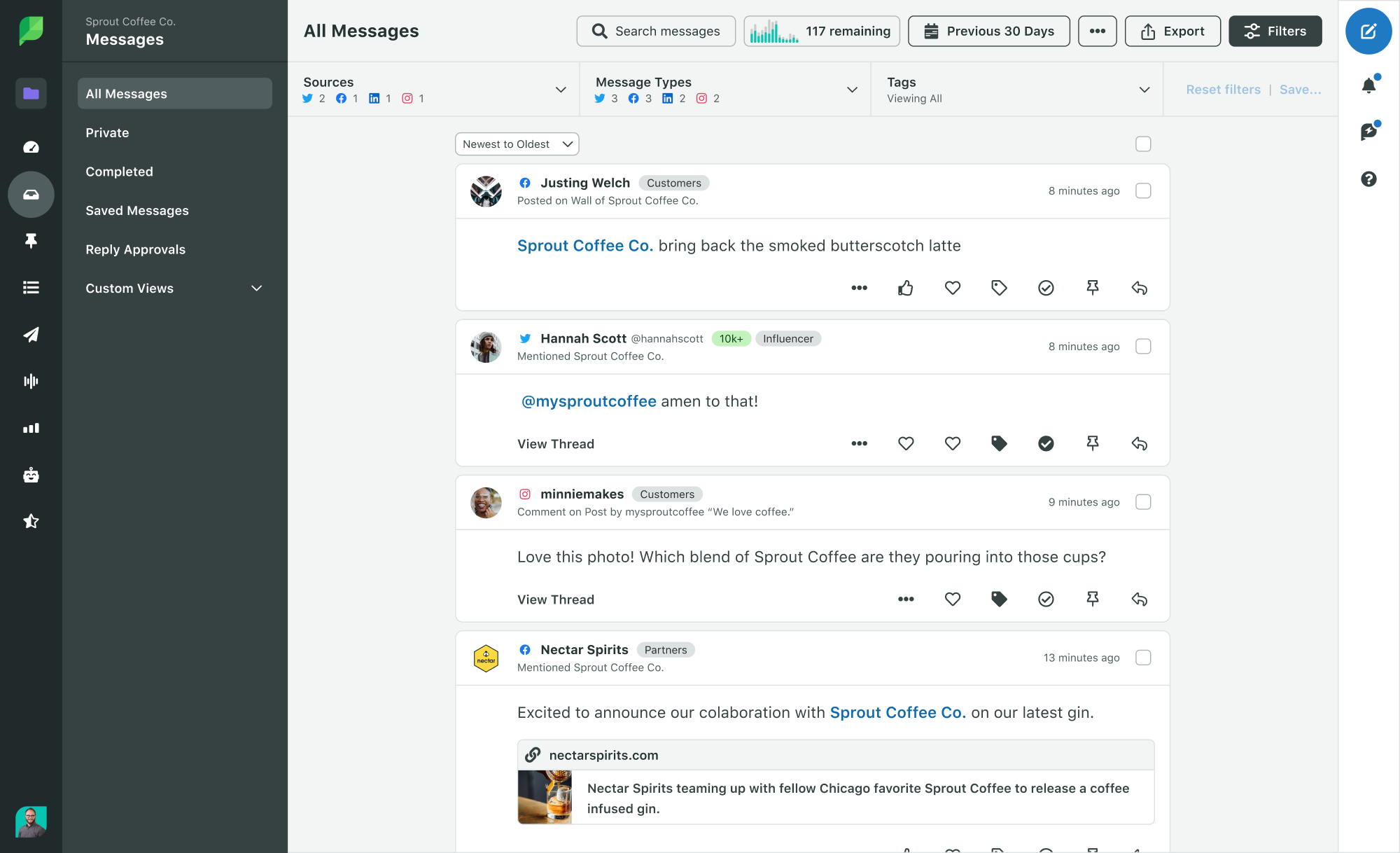Strong digital customer service is an expectation, not an exception to the rule.
Because the days of customers sitting on hold or reps saying “I don’t know” are long gone.
Modern buyers expect customer care that’s swift, comprehensive and seamless. They likewise expect brands to deliver all of the above through digital customer service.
This can be a tall order for brands with limited personnel. However, with the right tools and strategy, brands of all sizes can use digital channels to offer quality care.
Below we explain how to build a meaningful digital customer service strategy from A to Z.
What is digital customer service?
Digital customer service is the act of supporting customers through online platforms. These include channels such as social media, email, forums and live chat. Effective digital customer service combines technology with human interactions to deliver timely, personalized support.
Through digital channels, brands can resolve issues and build connections faster to increase customer satisfaction. More support channels mean more flexibility for customers to choose their preferred method of support, all on their own terms.
Digital customer service empowers brands to be in multiple places at once. Of course, doing so effectively is a balancing act that requires the right tools and prioritizing the proper channels.
The advantages of digital customer service for your brand
The concept of digital customer service might not be breaking news.
However, many companies are still catching up with customer service technology and trends.
Especially with the boom of AI and more customer interactions happening across social media platforms. Despite these challenges, brands can’t afford to fall behind with customer care.
Below we dig into the value of having a comprehensive digital customer service strategy.
Retain more customers and increase loyalty
Recent research on modern customer service highlights how speedy and comprehensive care translates into retention and loyalty.
Food for thought: 63% of consumers agree that the quality of social customer support significantly influences their loyalty to a brand they provide.
Translation? Stepping up your customer service goes hand-in-hand with doing better business.
Address more customer concerns without having to wait
The longer a customer’s concern goes unanswered, the more potential for tension and conflict.
Through digital customer service, brands can offer multiple channels to get answers on their terms. This includes opportunities for instant answers without having to wait for a rep to respond.
Think about it. Some people prefer customer service chatbots versus one-on-one interactions. Other customers or concerns require personalized care from reps in real-time.
And hey, that’s okay! The beauty of digital customer service is that it’s not a matter of either-or.
Take tedious tasks off of your service team’s plates
Anything you can do to make life easier for your service reps or support team is a plus.
Thankfully, the latest wave of AI customer service options has made automation more accessible for teams to streamline tasks that’d otherwise require manual data entry or reporting.
The result? Reps are more available to respond to high-priority and timely concerns. This highlights how digital customer service is a benefit for both your team and your customers.
Build your brand’s reputation with stronger customer care
Some brands (think: Chewy) have made five-star customer service their trademark.
Consider how positive interactions with customers serve as great marketing for your business.

Source: Twitter
Frequent shout-outs, social mentions and compliments from customers are brilliant for building word-of-mouth. Not to mention that they prove your digital customer service strategy is working.
Learn more about your customers to provide better service long-term
This is a big one. Customer service done digitally is so much easier to document than face-to-face interactions or conversations that happen offline.
For example, you can learn more about your customers’ challenges or assess your company’s response time with confidence if you track everything digitally. That means you can benchmark your success team’s performance and understand opportunities to optimize with confidence.
Proven methods for a digital customer service strategy
Simply put, you can’t afford to “wing it” with your customer service strategy.
Here are the best practices for digital customer service regardless of your business or industry.
1. Offer multichannel support
First things first: you need to provide support across multiple channels for speed and flexibility.
For example, check out how this brand provides their site visitors with a mix of options to get help and answers. This includes:
- Instant support via chatbots and an FAQ resource
- Real-time support from live chat or phone
- Additional personalized support via email or text messages

As noted earlier, no two customers are the same in terms of their needs and expectations. Some want to talk to reps. Others would rather stick to self-service options. Rather than forcing customers to choose, it’s safer to provide multiple options (granted, you have to have the bandwidth to monitor them).
2. Actively collect data to inform your customer service strategy
Every digital customer service interaction is an opportunity to fine-tune your agents’ approach.
This includes challenging customers, successful resolutions and everything in between.
Learning where you’re winning and where there’s room for improvement boils down to data. Ideally, your tech stack allows you to track customer service metrics such as:
- Average first reply time
- Average wait time
- Customer abandonment rate
- Total message and response volume
- Reply or response rate
- Resolution rate
Coupled with sentiment analysis (Think: Tracking phrases from customer calls or common phrases you can also uncover):
- How customers feel about your brand versus competitors
- Common challenges and pain points
- What customers like best about your service
Tracking all of the above can help you create benchmarks and undercover opportunities to improve your digital customer service strategy long-term.
3. Always provide a “human” service option
Like we said, providing quality customer service is a balancing act.
Finding the perfect balance between speed and personalization can be tricky. It’s tempting to automate as much as you can for convenience and speed.
However, relying too much on bots and knowledge bases can lead to negative or frustrating experiences for customers. Especially those that simply want to talk to a real person.
Check out how Dell offers multichannel digital service options, including multiple opportunities to speak to an agent.

Of course, not every little concern demands a live response. That’s why establishing customer service tiers is a crucial piece of building your digital strategy.
4. Consider collaborative spaces to address customer concerns
Food for thought: If one customer has a concern, chances are many others have (or will!) the same issue. This is particularly true for SaaS brands and software companies.
That’s why it’s a smart move to establish forums or communities to address service questions publicly.
Some brands have community forums where users assist each other with their website issues. Most of the content is totally community-driven but employees can step in to resolve problems if needed as well.
These collaborative spaces can serve as an ongoing resource you can point others to in the future. This approach reduces one-on-one interactions with reps while also serving to build out your knowledge base over time with help from your own audience.
5. Put names and faces to your agents if possible
Despite popular belief, digital customer service doesn’t have to be robotic. Quite the opposite!
Piggybacking on some of the best practices above, it’s important not to lose the human element of service when you double down on digital channels. Here are some examples of how:
- Include actual agent avatars and names within your chatbot routing
- Assign employees to respond to customer questions and concerns in public spaces
- Have agents “sign” their social customer service responses
Note how Salesforce has its own “Sales Leaders” within its company’s support forum. This is a subtle yet significant way to make your digital service strategy feel more human.

6. Give your reps a source of truth for customer care
The more you know about a customer, the more personalized service you can provide.
Consistent and comprehensive care means tracking the customer journey from A to Z. With the help of a CRM or a tool like Sprout Social’s Smart Inbox, you can see how a customer has interacted with your brand in the past which can clue you in on how to better help them in the future.

This is a must-do when managing social customer care among larger teams. Chances are your customers aren’t always going to interact with the same person day in and day out. This is why it’s crucial to make sure every rep is empowered to help customers regardless of their history.
7. Close the loop on customer feedback
This is where it all comes together. With a closed-loop feedback system, you’re continuously improving your customer service. In digital customer service, this can be applied by:
- Collecting feedback via social media, chatbots or surveys
- Analyzing feedback to identify positive trends or customer challenges
- Implementing changes like improving website navigation or training agents on new issues
- Communicating actions taken to the customer to show their feedback was valued
- Measuring the impact of changes to refine your strategy in the future
This helps you hold your company accountable for not only tracking interactions but actually implementing the feedback you’ve received.
Digital customer service examples
To wrap things up, let’s look at some actual examples to inspire your own digital customer service strategy. These examples highlight how different approaches can result in positive outcomes.
Sprout Social
Sprout Social has firsthand experience in improving social customer service.
For example, the support team learned that agents could focus on more high-priority issues instead of responding to small events like new follower notifications.
Using the Smart Inbox capability, Sprout was seamlessly able to monitor and optimize its own customer care activities across multiple social channels. The ability for agents to set rules and track notifications for relevant social comments resulted in speedy replies and delighted responses from customers. All without requiring a ton of training for agents.

Fitbit
Fitbit’s multichannel service options are a great example of how companies can cover their bases when it comes to customer care. The company’s Help Center provides various contact options for customers having issues and even notes which ones aren’t available at any given moment.

Coupled with a comprehensive help forumwhere customers can track common issues, the brand has structured its help content so that people can get relevant answers ASAP.

Reverb
Automation is among the biggest customer service trends but it’s anything but a buzzword.
Reverb’s chatbot and knowledge base show how to streamline digital customer service by routing people to quick answers and comprehensive content at the same time.

The company’s chatbot “Trem” provides a list of resources based on common issues broken down by subqueries in the company’s Help Center. Note the “Quick answer” at the top of each query. The company also provides prompts to talk to a real-life rep if needed.

Reverb highlights how your digital customer service strategy and content can align with each other. Chatbots can integrate with your existing knowledge base but seamlessly move customers to an actual rep if their situation requires it. This means the best of both worlds for customers.
Taking your digital customer care to the next level
Offering digital service to your customers isn’t a matter of “if,” it’s a matter of “How much?”
The more channels you cover and monitor, the more you can learn and improve your level of care over time. This applies to current customers, future site visitors and your followers on social media.
And speaking of!
Social media is integral to modern digital customer service, especially given how much time people spend on TikTok, Instagram and X. Check out our guide on social media customer service for actionable ways to maximize touchpoints and provide top-tier service to your brand’s community.
The post What is digital customer service?: A complete guide appeared first on Sprout Social.

